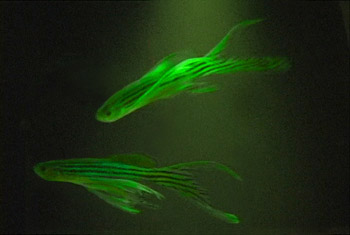GFP studies for life that Glows-In-The-Dark


The Eighth Day - GFP as art
Mech Dev 1998 Aug;76(1-2):79-90 - Abstract on UofT GFP reaserch
Andras Nagy - Lunenfeld Institute, University of Toronto (GFP studies)
Samuel Lunenfeld Research Institute, Room 881
Mount Sinai Hospital
600 University Avenue
Toronto, Ontario, Canada
M5G 1X5
Andras Nagy - office phone: (416) 586-3246 ; email: nagy@mshri.on.ca
Lab phone: (416) 586-8455
Secretary phone: (416)-586-5361; email: bowen@mshri.on.ca
Fax: (416) 586-8588
http://news.bbc.co.uk/2/hi/science/nature/484809.stm
Monday, October 25, 1999
GM Christmas tree would glow
No more ceremonial switch-ons?
Frustrated fiddling with Christmas tree fairy lights could become a thing of the past as genetic engineers have proposed a tree which grows its own lights.
The idea for glowing pine needles was dreamed up by five postgraduate students at the University of Hertfordshire, UK, as their entry in a biotechnology competition.
It is a perfectly possible proposition, as genetic engineers elsewhere have already created glowing mice, silk and potatoes.
'Only problem cost'
Neurophysiology student Katy Presland, 29, said: "We're talking about a green luminescent Christmas tree that glows in the dark and produces a noticeable light during the day.
"It is quite feasible. The only problem in reality is the cost," she added.
"We calculate that the initial trees would cost about £200, which means going for the upper end of the market. But I'm sure a lot of people would love them, especially the Americans."
Jellyfish and fireflies
The team detail a plan to modify a Douglas spruce with two genes to make it illuminate. These would taken from fluorescent jellyfish and fireflies. The first gene produces a substance called green fluorescent protein (GFP), while the second results in an enzyme called luciferase.
The trees would be modified by infecting seedlings with a harmless bacterium carrying the genes. A chemical compound called luciferin is needed to activate luciferase, which in turn "switches on" GFP and makes it glow.
In the case of the luminous Douglas spruce, the luciferin would be mixed into a special fertilizer sold with the tree.
The genes for green fluorescence have been widely used by genetic engineers because they allows scientists to see at a glance whether an attempt to introduce a gene into an organism has been successful.
Blue fluorescent proteins have also been discovered and, last month, a red fluorescent protein was found in a coral. This means that, in theory, the GM Christmas tree could grow its own multicoloured lights.


Last updated June 4th, 2003





